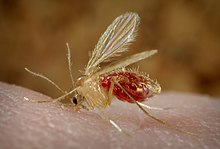Sandfly
Sandflies are a group of flies, many of which feed on blood and are vectors of parasites.
| Sand flies | |
|---|---|

| |
| Phlebotomus papatasi | |
| Scientific classification | |
| Kingdom: | |
| Phylum: | |
| Class: | |
| Order: | |
| Suborder: | |
| Family: | |
| Subfamily: | Phlebotominae
|
The group is the Phlebotominae, a subfamily of flies.[1] Parasitic diseases spread by the flies include leishmaniasis, bartonellosis and pappataci fever. In the New World leishmaniasis is spread by sand flies in the genus Lutzomyia. Lutzomyia often live in caves, where their main hosts are bats. In the Old World sand flies in the genus Phlebotomus spread leishmaniasis.
Phlebotomine females, and only females, suck blood from various mammals, reptiles and birds. Some species are selective, whereas others bite any suitable host they find. All species need a blood meal for every following clutch of eggs after the first. Proteins and other nutrients in the blood enable the female to produce eggs.[2]
The flies use their mouthparts to start the host bleeding. They then suck up the exposed blood. Like practically all blood-feeding parasites, they inject biochemicals that inhibit blood clotting, plus some that stimulate host mast cells to produce histamine; this distend capillary vessels, thereby promoting blood flow.[3]
One blood meal can support the production of about 100 eggs. Females lay their eggs in humid soil rich in organic matter.
Sand flies are small; a body size of about 3mm in length is typical. This helps them in escape notice. Their bite is not always felt, but leaves a small round, reddish bump that starts itching hours or days later. Use of insect repellent is recommended in areas where sand flies are present.
References
change- ↑ Sometimes the name is applied to other insects as well.
- ↑ Braverman Y. 1994. Nematocera (Ceratopogonidae, Psychodidae, Simuliidae and Culicidae) and control methods. Rev. Sci. Oech. Off. Int. Epiz., 13(4), 1175-1199
- ↑ Killick-Kendrick R. 1999. The biology and control of Phlebotomine sand flies. Clinics in Dermatology 17 (3): 279–89. [1]